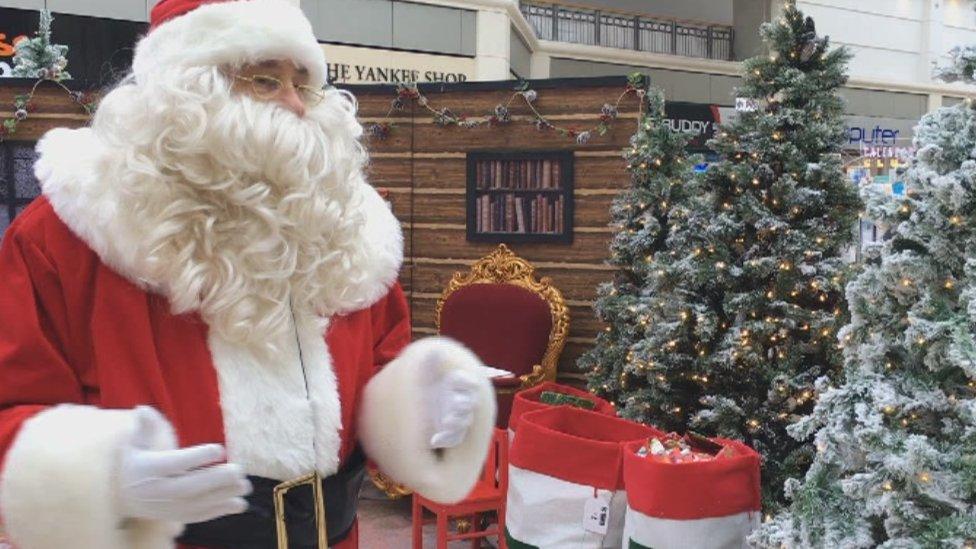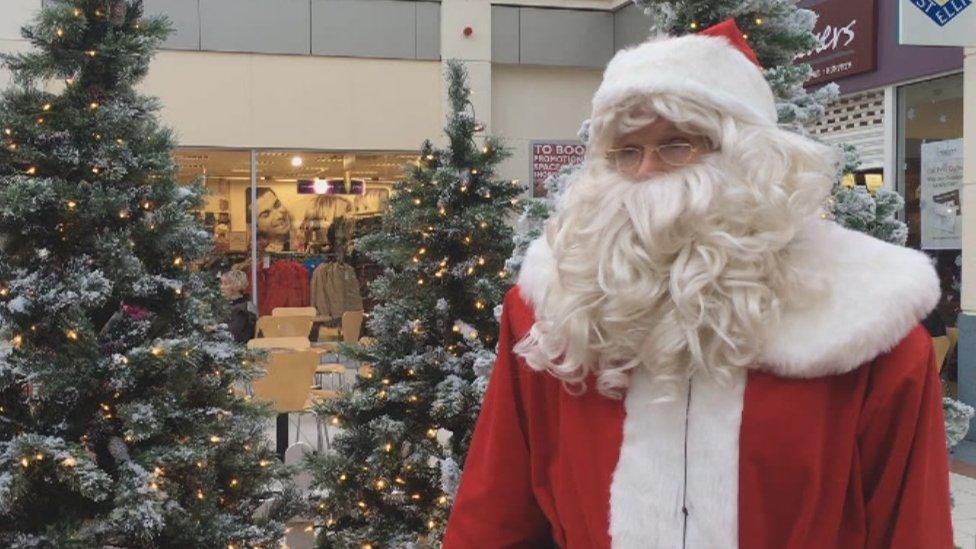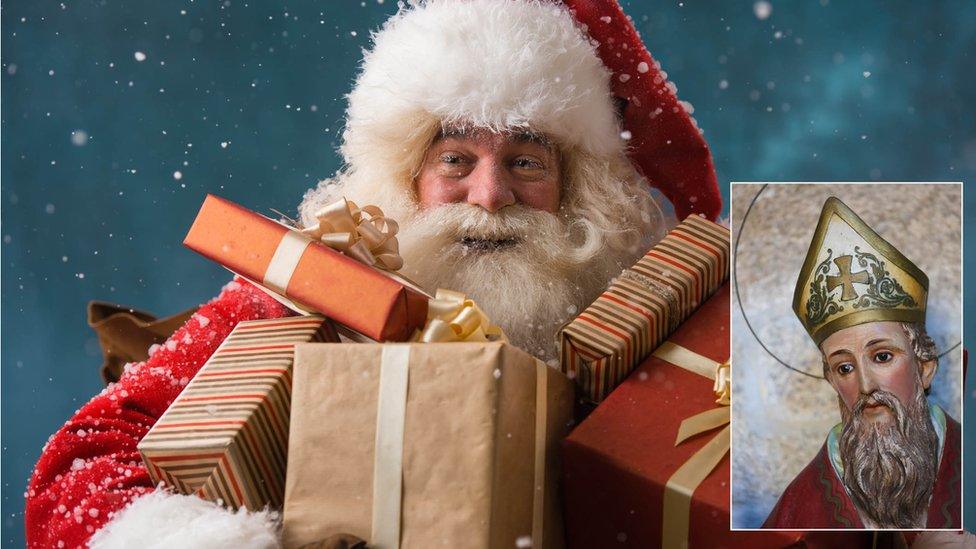Why work as Santa Claus, an elf or a light untangler?
- Published

John Jones, 72, says his Santa job gives him a reason to leave the house
"I'm fed up with mince pies," joked retired ambulance worker, John Jones who has worked as Father Christmas for seven years in a row.
The 72-year-old is among the hundreds across Wales who personify the season of goodwill in red robes and tireless smiles as professional Santas and elves.
But why apply for a job spreading yuletide cheer? And what do Christmas workers do for the rest of the year?
The BBC spoke to some seasonal workers to discover the perks, privileges and professional challenges connected with clocking in at the grotto.
Elves Amy Powell (l) and Marie-Julie Cnydde (r) with Santa, John Kirkhouse, 76
Mr Jones, of Llanelli, a former county councillor and magistrate, has worked five days a week over the past month at the town's St Elli Centre.
"It's a pleasant job, you see the children, you make people happy - what more do you want," he said.
"A few hours a day I get out, I leave the wife in the house and I'm free to come here."
'So hot'
And when his two-and-a-half hour shift is over, there is the carefully-timed operation of passing on the tinselled baton to successor John Kirkhouse, 76, who waits in the changing room in his own beard and boots.
It would not do for children to see two Santas simultaneously at the shopping centre.
"It's all right for a few weeks - you get so hot," Mr Kirkhouse said, gesturing to his outfit.
The retired postman, who has been pulling on the stocking cap and gold-rimmed spectacles for 13 years, said - the heat notwithstanding - he "loves" the job.
"It's an easier job than working as a postman because you're out all weathers there, but you're indoors here."

John Kirkhouse, 76, on his way to reporting for duty
But what makes a good Santa?
"It's the way you talk to the children and the way the children come back and talk to you. You've got to make them want to know you," Mr Kirkhouse said.
However, if a would-be Kris Kringle is not a natural, how do you ensure they are up to the task of filling his fur-lined boots? With training, of course.
Great Grottos Ltd, which runs the Santa stop at St Elli Centre, gives all their staff a day of hints, tips and role-plays to ensure they know how to jingle the right bells.
'Dos and don'ts'
Grotto manager or head elf, Amy Powell, 22, said: "Before our training we get a slideshow that tells us all about the tricks of the trade and the responsibilities we have of being an elf, what our costume should look like, all the dos and don'ts.
"Head office comes down for the day and we have training here in the grotto and we make sure that everyone is comfortable with what they are doing."
Ms Powell, of Swansea, is taking a break from her career as a nursery practitioner and brushing up on skills she learned as an entertainer at holiday camps.
"It's not a normal job where you're sat in an office, we just get to do exciting stuff," she said. "I get to be an elf - it's something different to put on the CV."

John Kirkhouse, 76, who's been a Santa for 13-years, says the costume can be a little warm
Junior Elf Marie-Julie Cnydde, 17, is studying her A-levels at Gower College and hopes to become a doctor, working with children.
She said: "The hours are quite nice. It's a weekend job for me, and because I'm still at school it allows me to carry on with my studies, and it's just a really fun job to have."
Her employers say the grotto jobs offers "flexible shifts" and "good hourly rates of pay".

The origins of Santa Claus

Santa Claus and (inset) Saint Nicholas
Derived from the British figure of Father Christmas, the Dutch figure of Sinterklaas, and St Nicholas, the historical Greek bishop who liked to secretly give gifts
Santa is often linked to Odin and the Germanic pagan midwinter event of Yule
Finnish illustrator Haddon Sundblom is often credited with having helped define the classic Santa image with his Coca-Cola images
The traditional Santa became popular in North America in the 19th Century after 1823 poem, A Visit From St. Nicholas , external, by Clement Clarke Moore
Santa's traditional "ho ho ho" festive laughter is first attributed to English mythological figure, Puck

Last month, it was the Santa salary at Newport's Celtic Manor Resort which caused a stir after the advertisement for its own Father Christmas vacancy included a £12-an-hour wage while that of Mrs Claus had an hourly rate of just £6.70. The hotel said the roles were "very different".
However, in his 2013 paper, Being Santa Claus: the pursuit of recognition in interactive service work, external, Prof Philip Hancock, of the University of Essex's business school, said hardly any of the Santas he had spoken to were doing it for the money.
After interviewing a number of "elite Santas", he discovered many found a deeper meaning. "Most of them had a genuine passion and belief in what the role could achieve," he said.

Anya Mugridge works as a Christmas lights untangler
Outside the network of grottos across Wales, the range of seasonal Christmas jobs is seemingly widening; Tesco Extra in Wrexham this year recruited a Christmas light untangler - believed to be Britain's first.
Anya Mugridge, 21, who is studying illustration, graphic novels and children's publishing at Glyndwr University, said the job has dovetailed well with her studies.
'Ball of doom'
But has she been stumped by any Gordion knots brought in by customers?
"The closest I had to that was when a gentleman came in and he had about three sets of lights bundled into one big ball of doom," she said.
- Published12 November 2015

- Published6 December 2014
